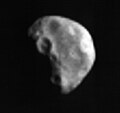Fasciculus:Dactyl-HiRes.jpg

Mensura huius perspectionis: 636 × 600 elementa imaginalia. Aliae mensurae: 255 × 240 elementa imaginalia | 509 × 480 elementa imaginalia | 892 × 841 elementa imaginalia.
Sua resolutio (892 × 841 elementa imaginalia, magnitudo fasciculi: 385 chiliocteti, typus MIME: image/jpeg)
Historia fasciculi
Presso die vel tempore fasciculum videbis, sicut tunc temporis apparuit.
| Dies/Tempus | Minutio | Dimensiones | Usor | Sententia | |
|---|---|---|---|---|---|
| recentissima | 04:37, 2 Aprilis 2018 |  | 892 × 841 (385 chiliocteti) | PlanetUser | Cropped 20 % horizontally and 20 % vertically using CropTool with precise mode. |
| 19:35, 12 Decembris 2017 |  | 1 115 × 1 051 (597 chiliocteti) | Newone | Better version | |
| 23:04, 25 Maii 2010 |  | 240 × 240 (16 chiliocteti) | Antonsusi | {{PD-USGov-NASA}} |
Nexus ad fasciculum
Ad hunc fasciculum nectit:
Usus fasciculi per inceptus Vicimediorum
Quae incepta Vici fasciculo utuntur:
- Usus in af.wikipedia.org
- Usus in ar.wikipedia.org
- Usus in ary.wikipedia.org
- Usus in arz.wikipedia.org
- Usus in az.wikipedia.org
- Usus in be.wikipedia.org
- Usus in bh.wikipedia.org
- Usus in bs.wikipedia.org
- Usus in ca.wikipedia.org
- Usus in ckb.wikipedia.org
- Usus in cs.wikipedia.org
- Usus in de.wikipedia.org
- Usus in el.wikipedia.org
- Usus in en.wikipedia.org
- Usus in es.wikipedia.org
- Usus in fi.wikipedia.org
- Usus in fr.wikipedia.org
- Usus in hy.wikipedia.org
- Usus in id.wikipedia.org
- Usus in it.wikipedia.org
- Usus in ja.wikipedia.org
- Usus in ko.wikipedia.org
- Usus in kv.wikipedia.org
- Usus in lb.wikipedia.org
- Usus in lt.wikipedia.org
- Usus in mk.wikipedia.org
- Usus in ms.wikipedia.org
- Usus in my.wikipedia.org
- Usus in nds.wikipedia.org
- Usus in ne.wikipedia.org
- Usus in nl.wikipedia.org
- Usus in no.wikipedia.org
View more global usage of this file.


